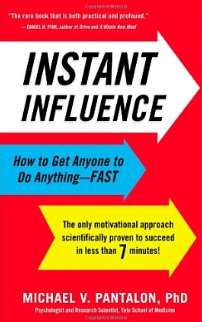I recently read “Instant Influence: How to Get Anyone to Do Anything – FAST” by Michael V Pantalon, PhD. Below are the quotes I found most interesting. As always, if you find the quotes interesting, please buy the book here.
 “People usually act for their own reasons, not someone else’s reasons. If they do change a behavior because of something someone else has said, most of the time that change won’t stick. The secret of Instant Influence is that it helps people discover their own reasons for doing something, even something they thought they didn’t want to do.” (5)
“People usually act for their own reasons, not someone else’s reasons. If they do change a behavior because of something someone else has said, most of the time that change won’t stick. The secret of Instant Influence is that it helps people discover their own reasons for doing something, even something they thought they didn’t want to do.” (5)
“Here are the six steps that will allow you to achieve Instant Influence:
Step 1: Why might you change?
Step 2: How ready are you to change – on a scale from 1 to 10, where 1 means “not ready at all” and 10 means “totally ready”?
Step 3: Why didn’t you pick a lower number? (Or if the influencee picked 1, either ask the second questions again, this time about a smaller step toward change, or ask, what would it atke for that 1 to turn into a 2?)
Step 4: Imagine you’ve changed. What would the positive outcomes be?
Step 5: Why are those outcomes important to you?
Step 6: What’s the next step, if any?” (5)
“If a person is deeply committed to refusing change, no motivational technique will make a difference. When someone genuinely doesn’t want to change, change won’t happen.” (11)
“At almost every turn, your efforts were doomed to fail. That’s because you were using what I like to call the tell-and-sell approach: you tell someone your reasons for doing something, then try to sell her on them.” (18)
“The other person might agree with you, but that won’t spark a desire to take action. That desire – the motivation to act – lives in each one of us. But the only way to unlock it is with our own reasons.” (18)
“Using the wrong type of encouragement can actually make a person want to do something less.” (18)
“People can tell you all day long that they wish they could do something. But when they tell you why they want to do it, that’s when things start to happen.” (19)
“That’s instant influence in a nutshell. Get someone to tell you why he wants to act, and action is almost sure to follow.” (19)
“This kind of question – Why are you even thinking about this? or, Why might you consider it? is another version of Step 1 of the Instant Influence process.” (23)
“Focusing on any tiny bit of motivation works much better than asking about resistance.” (25)
“Hearing ourselves say what we want to do helps us find the motivation to do it.” (31)
“My trainees can’t quite believe that simply saying “I’d really like to do X” will actually make it more likely that the person will, in fact, do X. I assure you that dozens of well respected studies have verified this point, magical as it may sound. The reason we’re so surprised, I think, is because we’re used to hearing people say “I should do X,” and that, of course, has virtually the opposite effect. The more we think we should do something, the less likely we may be to do it, particularly when the law of psychological reactance kicks in.” (31)
“You can modify Step 1 of the Instant Influence technique to focus on actual behavior. Instead of asking, “Why might you change?” you could ask, “Why have you already taken [some action that represents a tiny step toward changing]?” (34)
“People’s actions often show that they have far more motivation than they are aware of. We can use the evidence of those actions to help them find even more motivation.” (34)
“For example, many studies have found that bonuses don’t promote more dedicated performance. Instead, they seem to motivate unethical behavior: shortcuts, cheating, and other ways to get the bonus that don’t involve doing a good job.” (51)
“If you can’t get someone to think, you won’t be able to influence him.” (74)
“Every time those baby steps (placing the manual by the computer) did the trick. Once he’d made even the least bit of progress, his natural motivation took over and carried him along.” (105)
“Choose something that you can literally see or hear yourself doing (an action) rather than something that remains in your mind only (a decision or a new way of thinking).” (107)
“Allow yourself to focus on behavior, and your decisions will take care of themselves.” (107)
“Improving the Process:
– Keep looking for smaller and smaller beginning steps until you find one that feels safe or that you can at least visualize doing.
– Don’t judge or self-censor. Just be open to the process.
– Explicitly remind yourself to ignore the hows and why nots. Focus instead on why you want something.
– Expect to get carried away. The tiniest step of sets in motion a series of thoughts, feelings, and ideas that create new momentum.
– Prepare to be surprised. You will almost certainly learn something new about your own reasons for wanting something.
– Trust the process. You may find yourself taking action almost without realizing it, so don’t feel you need to force yourself.” (116)
“Research suggests that when people are presented with illogical, odd, unrelated, or irrational material – in scientific terms, “meaning-threat” material – they tend to arrive at better solutions in less time.” (117)
“As we’ve seen, we often focus too much on the how when we really should be looking at the why.” (120)
“Occasionally, we take on the wishes of people around us – parents, partners, even friends – instead of acknowledging our true desires. We believe in those false dreams, then wonder why we can never seem to take action to make them come true. All too often, our true desires scare us, either because they seem difficult to attain or because achieving them would shake things up elsewhere in our lives.” (126)
[when dealing with customer service] “You need to detach from any sense of being in a power struggle and instead focus on getting what you want. The person you’re dealing with may never acknowledge your right to what you want – but he may find a way to give it to you. His motivation for doing so, however, will probably not come from a sudden awareness of the correctness of your position. Rather, it will spring from discovering why he wants to help you even though he doesn’t have to. If your goal is to prove to him that he does have to help you, you’re setting yourself up for failure.” (162)
“Need is often just another way of saying should, and anytime the word should is used, we risk triggering the law of psychological reactance.” (178)
“If someone is giving you reasons talk, remember the “five whys.” If you can, keep asking, “And why is that important?” until you hear a response that feels genuinely personal and heartfelt.” (180)
“As hard as it is to believe, such excuses are good news. Giving reasons for not doing something is one of the strongest signs that a person is seriously considering doing it.” (188)
“I know how easy it is to fall into the role of the person with all the answers. But I’ve also seen, time and again, that giving up that authority and genuinely investing in the person’s autonomy can have enormous dividends, as he reveals himself to be a more independent, self-confident, and creative person than we ever might have dreamed.” (201)
“Edwin Locke and Gary Latham found in a landmark study: when workers set their own goals, they set goals that were harder to achieve than the ones supervisors assigned to them – and they were more likely to achieve those goals.” (202)
“People often like the attention that comes from others being concerned about them. Without consciously realizing it, they refuse to change as long as people take an interest in helping them.” (216)
As always, if you found the quotes interesting, please buy the book here.

